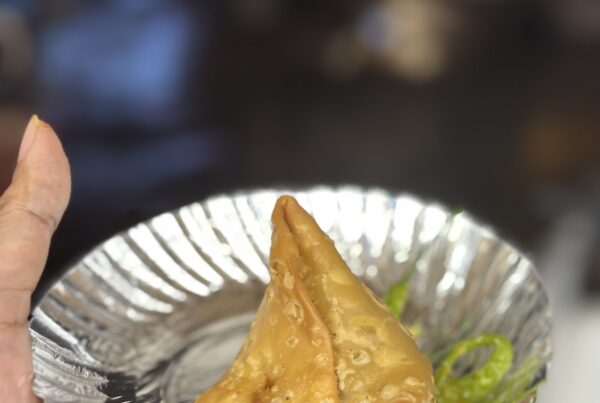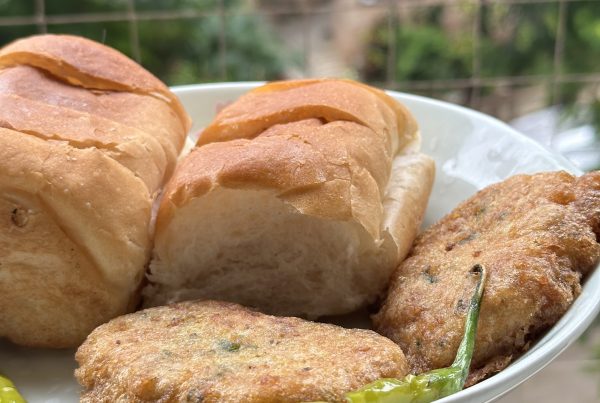 |
| My attempt to plate the Culinary Kitchen’s Gudi Padwa thali |
We live in strange times. Home chefs want to deliver restaurant-like food. Restaurants want to deliver home-like food.
I have no complaints. One gets to enjoy a larger chunk of the Indian culinary canvas thanks to this. Of course, there are limits to how often you can get yourself invited to people’s homes to eat.
That is where the entire commercial regional home food focus helps. Take this weekend for example.
Maharashtra: Gudi Padwa
I got to experience a Gudi Padwa meal preview on Saturday. Gudi Padwa is a spring festival that heralds the beginning of a new year for the Maharashtrian and Konkani Hindus.
The meal was sent by Amol Welling. I said yes to his offer after I got the go-ahead from my diabetologist. Let me give you the back story to this. I had been careful about my diet last month. I cut down on snacking after dinner, eating out, consumption of refined flour, restricted consumption of bread to once a day, and stayed away from sugar-free desserts and ice creams as suggested by the clinic dietician. As I found out later in the evening from a test, all these measures had helped me take baby steps towards reaching my goals. The Gudi Padwa meal, which was vegetarian and Satvik, was in a sense a small little reward for my efforts.
I have tried Amol’s food in the past and have liked it. Amol is not a home chef. He used to manage banquet halls in the pre-pandemic era. He opened a catering business called Culinary Kitchen during the pandemic. He hired cooks who specialise in traditional Maharashtrian and Goan dishes. The business seems to have done well enough for him to continue with it.
He pulled all stops for the Gudi Padwa meal and sent a banana leaf to eat it on. He did not give a blueprint for arranging the food. I like to get the order of thalis right. I googled and found an image to follow and was rather pleased with how I laid it out. This is where Marina Balakrishnan aces it. The way she sends notes which describe each dish in her delivery box, right up to how to arrange it, is a model for home chefs to follow.
The menu was a mix of the familiar, the not-so-familiar; and the not-familiar. Do keep in mind that I have lived in Mumbai for 25 years hence the meal did not entirely give me a ‘first time ever’ experience. I loved the way the meal came together and the sense of nourishment it offered despite coming from a caterer’s kitchen. To me, it spoke of the owner’s involvement in what went out to the customer.
The varan bhaat dal sukha – steamed rice, pigeon pea dal and a dry potato bhaji. is something that I ask our morning cook to make if I am feeling under the weather There was bharli wangi. Baby aubergine stuffed with spices. Every part of Maharashtra has its own version. This was lighter compared to the spicy and oily ones that I’ve had in restaurants and was slightly sweet. The pineapple-based gravy (ansaphanaschi bhaji) was fruity, sweet and new to me. The masala bhaat, a masala and vegetable-packed Maharshtrian pulao was not oily, was very pleasant to eat and was rather addictive. There were soft rotis (pol), rather than puris, which was good from the health point of view. The chutney/ pickle called panch amrut plus mango pickle. And a thin aamras. The final set will have a shrikhand made in-house on the big day.
I would recommend that you order this for lunch on the 22nd. Here’s their Instagram page for you to order from. The meal is enough for two. I have placed an order for K’s mama.
Odisha: Pakhala Dibasa
 |
| This is how I plated Sneha Senapati’s Pakhala Dibasa meal |
Moving from the west to the east, I got to try out an Odia meal presented by Sneha Sanapati in collaboration with WTF Versova on Sunday. This was part of a limited number of pop-up meals organised to celebrate Pakhala Dibasa which falls on 20th March. Pakhala Dibasa is a day set aside to preserve and promote this traditional dish of Odisha. Pakhal refers to cooked rice in water or in slightly fermented water or even in curd. The dish is part of the prasad served at the Jagannath Temple in Puri.
Sneha is one of our favourite home chefs in Mumbai. Her food is light and smacks of the taste of home. Her cooking is a tribute to her mother from whom she learnt how to cook and who has unfortunately passed away. Being Bengali, I find a hint of familiarity in the Odia food that Sneha cooks.
The only ‘problem’ with Sneha is that she works in the corporate sector and hence her pop-ups are few and far apart. My advice to her has been to find her own equilibrium and not be in a hurry to take a decision on what she wants to do in life.
I could not make it to Versona unfortunately and Sneha most kindly offered to send me a portion. This was an offer that I could not, or rather would not. refuse.
I took the non-vegetarian option. I loved the tanka tarani (buttermilk). The pakhala bhaat itself was so wonderfully cooling and soporific on a Sunday afternoon. It came with a set of accompaniments. The crunchy badi chuda which gave a playful start to the proceedings, sukhua chhecha with dried fish which tickled one’s palate and was not smelly at all, spiced mashed potato (alu bharta), smoked tomato poda, kaatla maccha bhaaja (fish fry) and chingudi channa (batter fried) prawns and a power-packed drumstick in a mustard gravy dish. Each dish was delightful and unique from the other. The perfect consort to rice and I took many second helpings.
I have had pakhala bhaat before. In this case, I was not on location and missed Sneha’s stories about the meal and explanations on how to eat it. That made me commit some gaffes which we will not talk about. Yet, I can say with a fair bit of confidence that this is an experience that I am unlikely to forget.
Enjoying meals from two ends of the country in one weekend. Does not get better this does it right?
Note: Both meals were sent to me as gifts




